

 
Timeline

The following collection of dates and activities has been drawn
from Argyle’s excellent local history books:
Come into our Heritage - R.M. of Argyle 1882 - 1982, Argyle Centennial
History Book Committee
Historical Sketches of Argyle Municipality, The Baldur High School
Centennial Committee
A timeline is a useful way to establish a community’s development, and
a good way to note its highlights. All of this information can be used
to develop the kind of content that is helpful in describing a
community’s history through short, effective and accurate texts that
will be appropriate for educational support materials, plaques, website
content, and myriad other follow-up projects. More notable activities
have been underlined.
The dates and activities have been presented in a decade-by-decade
format, which allows us to relive the past through the lens of the flow
of time; but it is important to note that pivotal events can also be
broadly grouped by major chronological periods in our history attached
to primary activities of a given era.

1600 – 1699
International
________________________________________
British Colonies are established along the east coast of North America.
These colonies would eventually become the “13 Colonies” that would
break away from Britain to form the United States.
Canada
________________________________________
What we now know as Central Canada (Quebec and Ontario) is called New
France. The profits available through the Fur Trade would prompt
westward exploration.
Manitoba
________________________________________
In the 1690’s Henry Kelsey travels southwest from Hudson Bay – to the
eastern edge of the Great Plains.
The Argyle Icelandic Settlement
________________________________________
When the first settlers arrived in Argyle it was obvious to them that
they were not the first inhabitants of this land. Native people often
passed through and evidence of past inhabitants was more visible in
those days, be it in the form of burial mounds or prairie trails. Stone
projectile points found in the Avery Mound (SW 14-3-13) near the
northeastern corner of Rock Lake, show that an early culture called The
Lake Shore Culture occupied the territory about 1500, BC. Although
settlement by the Sioux, Algonquin, Plains Cree and Assiniboine people
was intermittent as befitted their dependence on the roving herds of
bison, it was ongoing and substantial. We know the region was then, as
it is now, a home. With that knowledge comes the understanding that the
story of the first peoples is still unfolding, and that it bears some
similarities to the story of our ancestors. They also migrated here,
likely as not led by advanced scouting parties (explorers?), and they
adapted to the land and took from it what they needed to survive and
even prosper.

1700
– 1799
International
________________________________________
1783: The United States of America gain independence from Britain after
a long military struggle.
Canada
________________________________________
1759: The Battle of the Plains of Abraham effectively gives Britain
control of the territory of New France. A treaty in 1763 formally cedes
the territory.
Manitoba
________________________________________
1738: The French Explorer, La Verendrye, builds Fort La Reine on the
Assiniboine River (near present day Portage La Prairie).
1760: Exploration of southern Manitoba is undertaken by both the Hudson
Bay Co. and the Northwest Co. with the establishment of fur trade posts
near Souris Mouth and Hartney beginning in the 1760 - 90’s.
The Argyle Icelandic Settlement
________________________________________
The closest fur trade post serving the Argyle region was in the Spruce
Woods to the north. Pine Fort or Fort Epinette was established in 1785
and continued to be the western headquarters for Indian trade until
1794. It was located on the NE quarter section of 36-8-14 west: David
Thompson visited the site in 1798 and B. Tyrrell located the remains of
the early fort as late as 1890. Pine Fort was the headquarters for
trade with the Mandan Indians of the Missouri country.

1800
– 1849
International
________________________________________
1804-06: Lewis and Clark lead an expedition across North-western
United States to the Pacific Ocean.
Canada
________________________________________
The War of 1812 – 14.
In what is essentially a war between The United States and Britain ,
Canada successfully repels and American invasion with the help of
native tribes. Many years later Dakota warriors, descendants of those
who fought, still treasured medals given for service the British Crown.
Manitoba
________________________________________
1812: The beginning of agricultural settlement in Manitoba with the
arrival of Selkirk Settlers. This would lead to the establishment of
Winnipeg as the commercial centre of the region.
1822: Peter Fidler noted the abundance of sturgeon at the intersection
of the Souris and Assiniboine Rivers. In the same year the forts
at this intersection were attacked by the Dakota.
The Argyle Icelandic Settlement
________________________________________
Several competing Fur Trade Posts operated near the confluence of the
Souris and Assiniboine between 1793 and 1828.
The Argyle Region in 1800 – 1849
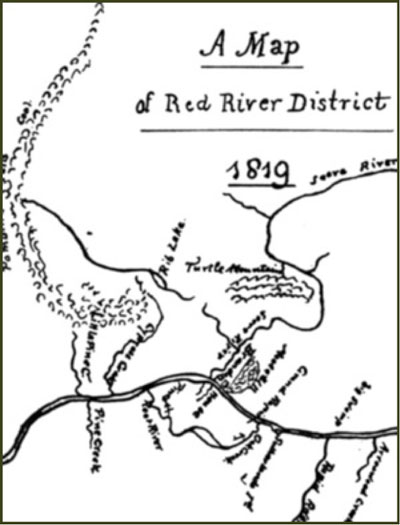
Peter Fidlers map - upside down! Note: Rib Lake - former name for the
Pelican - Rock Lake feature.

1850 – 1869
International
________________________________________
1861-65: Civil War in the U.S.
1848-52: Potato blight causes extensive crop failures in Ireland.
Canada
________________________________________
1867: Confederation united four British Colonies to create Canada. From
the outset, leaders like John. A. MacDonald envisioned a Canada that
stretched westward across the Prairies to the Pacific.
Manitoba
________________________________________
1859: Expeditions by Capt. Palliser and Henry Youle Hind explore the
Northwest Territories to examine the suitability of the region for
agricultural settlement.
1869: Louis Riel leads a group of Metis in the formation of a
provisional government.
The Argyle Icelandic Settlement
________________________________________
The Red River Metis on their annual bison hunt would often pass west of
Rock Lake in the region we now know as Neelin. There is evidence that
some Metis later returned to settle.
The Argyle Region in 1850 – 1869
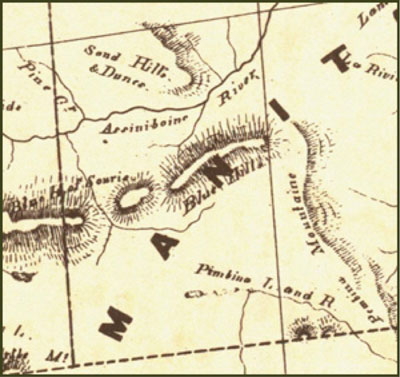
|
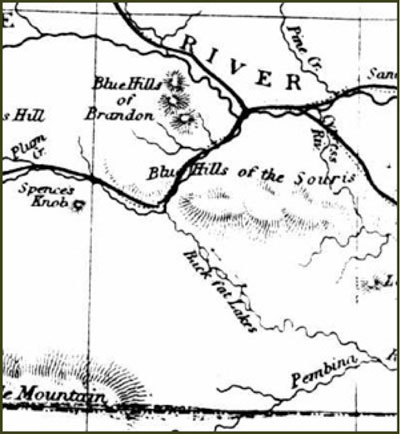
|
These maps show the region about 1859.
The British North American Exploring Expedition, commonly called the
Palliser Expedition, explored and surveyed the open prairies and rugged
wilderness of western Canada from 1857 to 1860. One purpose was to to
assess the regions potential for agricultural settlement

1870 – 1879
International
________________________________________
1876: Battle of Little Bighorn, June 25 and 26. A combined
Lakota, Northern Cheyenne and Arapaho force, overwhelms the 7th Cavalry
Regiment of the United States.
1876: Alexander Graham Bell successfully transmits the first
bi-directional transmission of clear speech. An improved design for the
“telephone” was patented the next year.
Canada
________________________________________
1874: The newly created Northwest Mounted Police march west from
Dufferin, Manitoba, on passing the Turtle Mountains they have a brief
glimpse of some of some Minnesota Sioux and their white captives.
Manitoba
________________________________________
1870: The Province of Manitoba enters Confederation largely on terms
put forward by Louis Riel.
1874: July 31 - First Russian Mennonites arrive at Winnipeg on the
steamer International.
1878: December 4 – the first freight by rail reached St.
Boniface.
First export of wheat from the prairies.
First grain elevator built in Niverville.
Steamboats service established the Assiniboine as far as Fort Ellice,
stopping at the Cypress River and Souris Mouth.
The Argyle Icelandic Settlement
________________________________________
In the early 1870’s a combination of economic factors and natural
disasters, such as volcanic eruptions in Iceland, prompted increased,
and large-scale emigrations to North America. On the advice of a
Missionary named John Taylor a large group of settlers arrived on the
west side of Lake Winnipeg in the late fall of 1875, establishing a
settlement that has shaped the culture of that part of Manitoba through
to the present day and was to spread to the Argyle region.
The Icelandic Settlement 1880 – 1889
1872
Hector Le Ber surveyed Townships 3 and 4 in Range 12 West during the
months of July, August and September of 1872. And during the same
months John and William Otty; and another set of brothers Walter and
David Beatty, surveyed the rest of Argyle in Ranges 13 and 14 West.
1875
In October of 1875, Sigtryggur Jonasson, with the assistance of John
Taylor, a missionary who was to become a lifelong friend to the
Icelanders, moved the settlers to the Keewatin District north of
Manitoba, along the shore of Lake Winnipeg. Here they established the
"State of New Iceland" with its own constitution, laws and government,
although in all except local matters, it remained under the authority
of the Canadian Government.
1878
The early settlers of the Glenora district arrived around 1878 and
settled in this district mainly around the north part of the Lake.
There were a number of experienced farmers among them from Ontario.
Years of early fall frosts brought disaster and suffering to heavy soil
farmers while lighter soil farmers produced a good sample of wheat with
fair yields. Among the first settlers are Noble and George Lawrence.
1879
John Wilson homesteaded on the Marringhurst plains. Mrs. Wilson was the
first white woman to settle in the district. John Cumming, former
soldier and ship’s captain, who first came to the Marringhurst area in
1879.

1880 – 1889
International
________________________________________
1882: Thomas Edison builds the first power plant in New York.
1885: Karl Benz patents his first automobile.
1889: The Eiffel Tower opens in Paris.
Canada
________________________________________
In 1885, after long-standing grievances remain unaddressed, Louise Riel
and Gabriel Dumont lead an uprising of Metis in the Saskatchewan River
Valley communities in the Prince Albert - Battleford regions.
Subsequent actions by native groups lead by Big Bear and Poundmaker
create concern in Manitoba communities but relations between settlers
and native people remain peaceful.
Manitoba
________________________________________
1881: March 2 - Manitoba Boundaries Act passed in Parliament, providing
for an extension of the province’s borders.
The town of Brandon is created in May of 1881 when the site is selected
over Grand Valley as a crossing and divisional point on the C.P.R.
Within a month it is a busy centre.
Homestead Regulations are eased to attract more settlers. Three options
existed:
1. Three year’s cultivation and residence – with the settler not absent
for more than six months in any one year.
2. Taking up residence for two years and nine months within two miles
of the homestead and then afterwards residing in a habitable house on
homestead for three months at any time prior to applying for the
patent. With 10 acres to be broken in the first year, 15 in the second,
and 15 in the third.
3. A five year system that allowed the settler to live anywhere for the
first two years as long as he began to cultivate the land within six
months and build a habitable house.
The Argyle Icelandic Settlement
________________________________________
The Argyle Icelanders
A combination of bad luck and bad weather combined with a smallpox
epidemic, harsh winters and wet summers made life extremely difficult
for Icelandic settlers near Gimli, but the colony persevered and
eventually thrived. For those that preferred fishing over farming the
location served them well once they adapted, but it wasn’t great farm
land and that likely prompted some to try their luck elsewhere.
Everett Parsonage, a pioneer of the Pilot Mound district, had worked
for John Taylor in Ontario and through him had contacts with some of
the Icelandic settlers at Gimli. He advised them to visit Argyle. In
August of 1880 Sigurdur Kristofferson and Kristian Jonsson set out to
vist Mr. Parsonage and he showed them a largely unsettled area in the
rolling country in the northern part of the Municipality, an area we
now know as
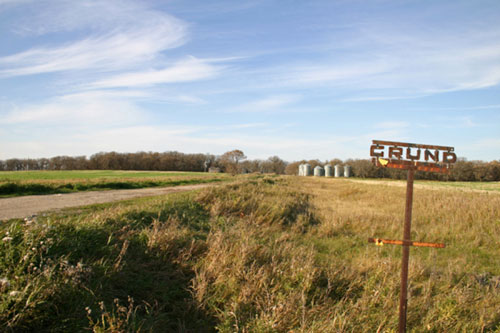
As soon as he could Sigurdur, filed on SE 10-6-14 and called his new
home “Grund”, An Icelandic word meaning grassy plain. More soon
followed, with two more men taking homesteads that fall. In the spring
of 1881 four families arrived at their new homes, by winter there were
eight families, then 17 by the next year. By 1884 they had “650
cultivated acres, 60 head of cattle, 62 oxen, 60 sheep, 9 work horses…”
and more. Six schools and a church were built by 1900. Before Baldur
was established a strong community was in place, and although the store
and post office established at Sigurdur Kristofferson home didn’t
evolve into a village, the name Grund has lived on.

1880
In the year 1880 the influx of settlers began in earnest to the east
half of the municipality.
In August, 1880, Sigurdur Kristofersson and Kristjan Jonsson set out to
visit their friend, Everett Parsonage, in Pilot Mound, travelling by
rowboat to Winnipeg, by steamer to Emerson, then walking by way of
Nelsonville, camping at night on this three-day trek. Parsonage guided
them to the area that became Grund.
In the Nelsonville land office Sigurdur filed entry for the first
homestead in the Icelandic settlement of what was to be Argyle - SE
10-6-14. He named his farm "Grund", an Icelandic word meaning grassy
plain
In the same year Christopherson, Arason, and Johnson hoisted the Union
Jack in the name of the Icelanders north of the Tiger Hills.
Other settlers of 1880: Sigurdur and Fridbjorn Frederickson
1881
By 1881 the first council of the newly created R.M. of Argyle was in
place although it was not active until 1882.
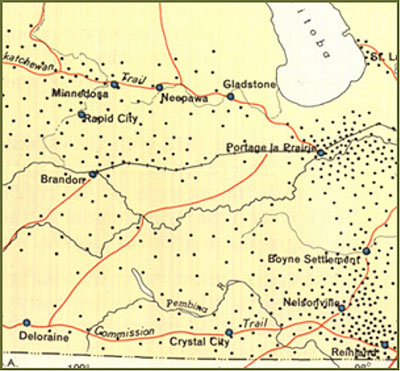
This 1881 map shows that the Argyle region was just beginning
to
attract settlement in 1881.
Weir, Thomas R. [Settlement 1870-1921] [map]. 1:3,041,280. In: Thomas
R. Weir. Economic Atlas of Manitoba. Winnipeg: Manitoba Dept. of
Industry and Commerce, 1960, pate 13.
(Warkentin and Ruggles. Historical Atlas of Manitoba. map 153, p. 332
Other settlers of 1881: Kristjan and Thora Anderson, Skuli and
Sigridur Anderson
1882
Other settlers of 1882: Bjorn and Kristin Anderson,
1884
Jon Olafson called the meeting. "All farmers" are present and 36
persons of over 18 years join in forming a congregation which they call
Frikirkju congregation, indicating by the name, their non attachment to
any state church. This was New Year's Day 1884. Trustees elected were:
Bjorn Jansson. Skapti Arason, Skull Arnason.
The original Hecla School was built on 16-6-14.
The first picnic in the district took place in 1884 at Jones's Lake.
Baldwin Benedickson entertained at stilts. Sigurjon Snydal shone in the
ox race.
A post office was established at Jon Olafsson's home at Bru in the
early 1880's. It was named Bru Post Office, the word "bru" being the
Icelandic word for bridge. The Olafsson home, later Albert Oliver's
home, was near the bridge on Oak Creek. The location was the northwest
corner of NE 16-6-13. At first Mr. Olafsson walked to Millford for the
mail, but later, when the railroad came through Cypress River in 1886,
he would get the mail at Cypress River.
The Bru Cemetery was established in 1884, on the northeast corner of NE
16-6-l3. A one-acre plot was donated by Jon Olafson
1885
Distance and mode of travel hampered the progress and continued growth
of the congregation. The result was that on July 26, 1885, the Frelsis
Congregation (Grund) was organized to serve the western community. The
two congregations later reached a compromise to build a church at
Grund. This was done and the church built in 1889. Therefore these two
congregations of Frikirkju (Bru) and Frelsis (Grund) worked together in
harmony for over 20 years and shared the same church building. During
these years they were served by Rev. Hafsteinn Petursson, Rev. Jon
Clemens, and Rev. Fridrik Hallgrimson.
The first Argyle Lutheran Ladies' Aid was held in a small log house the
home of Hildur Thorsteinson, in June, 1885.
1887
Some writers record Bru S.D. No. 368 as having been established as
early as 1885, with Mr. McBain as the first teacher. However, the first
official register of attendance is for 1887, with 19 pupils enrolled.
The first school building was on SE 16-6-13, the homestead of Bjorn
Jonsson, and the present residence of Claire Johnson.
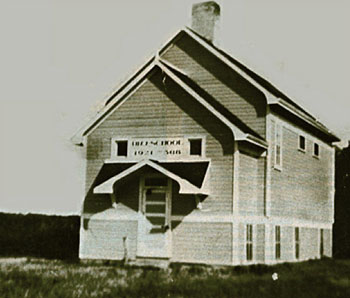
Bru School
1889
At a joint meeting in 1888, the Bru and Grund congregations decided to
invite the Synod to hold their 1889 convention in Argyle municipality,
and they also agreed to build a church.
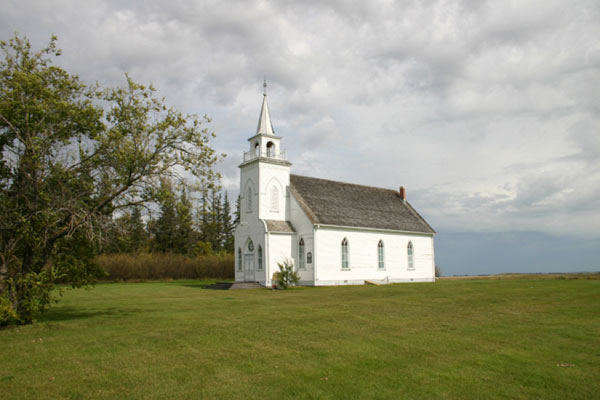
Frelsis (Grund) Church built.
Frelsis Church in 2010
At a joint meeting in March, 1889, it had been decided to call a
minister. Ninety dollars was collected and sent to Hafsteinn Pjetursson
in Iceland. He came immediately, was ordained in Winnipeg, and served
the district until 1893, for a salary of $500.
The Northern Pacific is run from Morris to Brandon.
Baldur is Born
In 1889, after several unsuccessful efforts to secure a much-needed
rail link, the Canadian Northern Pacific Railroad (a branch of the
American company), proposed a line linking Morris with Brandon and
passing through the center of Argyle. The towns of Greenway and Belmont
were quickly established. But that left quite a stretch without a
station and farmers felt they deserved better service.
Settlers in the district directly west of the present town and the
north and south were not sat¬isfied. To their way of thinking, a
station should be placed between, Greenway and Belmont.
While the surveyors were busy grading the line, farmers in the Otenaw
district lead by A.W Playfair, suceeded in convincing the railway
company that another station was needed. The first site chosen was
three miles west of the present town and again citizens including Jesse
Chester, Reeve Peter Strang and Sigurdur Chistopherson, rallied in
support of the current location. The surveyor reconsidered and chose a
location a few miles further east. This still wasn’t what the locals
had in mind and Jesse Chester apparently carried the surveyor’s
equipment himself to the current site. His persuasion won out and in
the spring of 1890 land was purchased from M.T. Cramer and Mr. Taggart
for $7.00 per acre.
Given that beginning, the name “Chesterville” suggested by a railway
official Mr. Lehorn would have seemed appropriate, but Sigurdur
Chistopherson’s daughter Carrie has been given credit for the
suggesting name “Baldur” the Nordic God of innocence and summer sun. A
vote settled the issue and Baldur it was. Carrie herself was recognized
in the name of the second avenue of the new town.
The development of the new town was well under way.

1890
– 1899
International
________________________________________
World’s Columbia Exposition (World Fair) opens in Chicago in 1893 – to
commemorate the 400th Anniversary of Columbus’s arrival in the new
world (1492). Featured prominently are exhibits highlighting the
possibilities of electricity.
Canada
________________________________________
1891: The end of the John A. McDonald era.
1896: Gold discovered in the Klondike.
Manitoba
________________________________________
Manitoba School’s Question divides the nation as governments decide on
the future of French Language instruction in schools.
The Manitoba Government authorizes the formation of local Farmer’s
Institutes and provides some grants. The goal is to improve farming
practices.
The Farmer’s Institute Act - 1890
The Argyle Icelandic Settlement
________________________________________
A decade of Growth
The Icelandic Settlement 1890 – 1899

1890
The Village of Baldur is established on a new rail line
In 1890, at a meeting in Argyle, Manitoba, a second district where
Icelanders congregated, three speakers argued for the extension of the
franchise, and the entire audience joined in the debate that followed.
The outstanding instrument in the suffrage campaign was the
Icelandic-language monthly, Freyja, meaning “Woman,” published between
1898 and 1910 by Sigfus and Margret Benedictsson.
1891
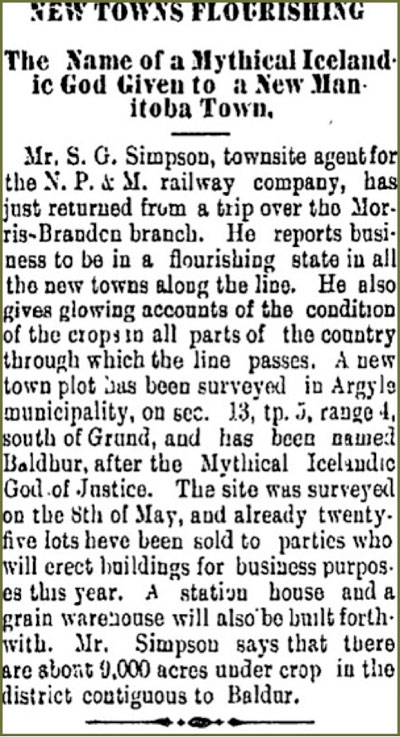
The Brandon Sun, Jun 5, 1891
1892
Sig. Christopherson, the first person to establish an implement shop,
sold to W. Hearn in 1892. Immediately C. Johnson built an implement
shop on a lot which he rented from S. Christopherson until W. 0. Fowler
bought it and later built his block and Chris Johnson had to
move. He bought a lot on its present site and as a dealer in
agricultural implements, Chris Johnson developed an excellent trade.
1893
Rev. Hafsteinn Pjetursson (Frelsis) 1889-1893
The Island Society was established in the year 1893, at Grund with
seven members. The object of its promoters was a most worthy one - the
supplying of literature to those who might not otherwise be in a
position to procure it, and thus tend to educate and elevate all, by
the perusal of the highest classes of literature.
1894
Stables were built that at Frelsis. Families from Frelsis joined
together in several groups to build three large barns - north and east
of the church. The last of these stood until 1944, when it was torn
down.
1894
On June 13, 1895 several ladies of the Frikirkju Church congregation
met at Josef and Malmfridur Bjornsson's home, NW 16-6-13 (Holmkell
Josephson's parents) to organize the Bru Ladies' Aid.
1896
The Skjalbreid Hall built in Grund in 1896 was used for various social
events.
The Library Society was instrumental in having Skjaldbreid built, and
for many years it was the scene of concerts, dances, plays, and various
celebrations. There the Good Templars met, the Ladies' Aid held their
tombolas; the Young People organized their club; and there were Sunday
School picnics.
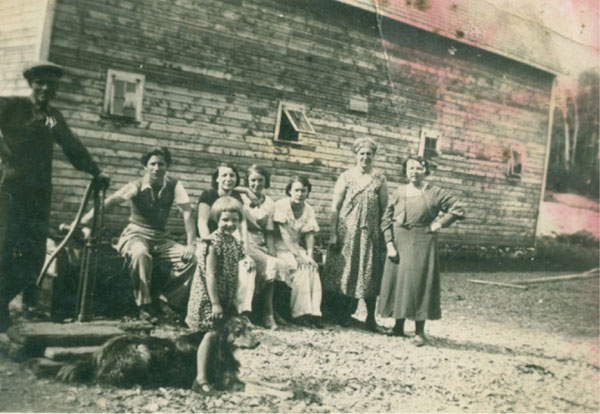
The Hall at Grund (photo courtesy Roy Christopherson)
In 1896, a belfry with steeple was added to the porch to house the 500
pound copper bell, which could be heard ringing clearly for five miles
1897
Frey SD. # 890 established on 24-6-14.
Mimir SD. # 891 and Hola SD. # 889, (1-6-14) established
In 1897, Bru School was moved to the northwest corner of SW 11-6-13.
Records show that in 1898, enrolment varied from 40-55, depending on
the season and age of the pupil, with trustees being Harvey Hayes,
Halldor Anderson and C.B. Johnson.
The Hola School District No. 889 was formed in the year 1897. The
schoolhouse and four-team stable were built in the spring of that year
on land bought from the crown - $3 for the dee·d.
A race track had been built north of the Grund hall about the year
1897, for horse and buggy races.
1898
The first publication of the Baldur Gazette appeared on June 30, 1898.
The Bru Hall was built on the northwest corner of NE 16-6-13. The land
was given or sold by Albert Oliver for the sum of $1.00. The deed for
the land was dated April 27, 1898. Apparently the hall was built that
year

1900 – 1909
International
________________________________________
1901: Queen Victoria dies, Jan. 22. Edward the VII reigns.
1901: Marconi sends the first radio signal across the Atlantic.
1903: Ford Motor Co. established to manufacture automobiles
Canada
________________________________________
May 15, 1909: An Earthquake is felt across the prairies.
Manitoba
________________________________________
1901: Manitoba’s first Hydro-electric plant opens on the Little
Saskatchewan River northwest of Brandon.
1906: Manitoba farmers organize the “Grain Growers’ Grain Company” with
shares available at $25. For any farmer wanting to join.
1908: Manitoba Government Telephones takes over the telephone service.
The Argyle Icelandic Settlement
________________________________________
The community reached what is termed the consolidation era (following
the pioneer and establishment eras). Rail and roads are established.The
initial spurts of growth have settled. Hastily erected frame buildings
are replaced with more substantial houses and barns. Recreational and
cultural options are explored.
The Icelandic Settlement 1900 – 1909

1901
Serious outbreaks of scarlet fever and mumps.
Rev. John Clemens
(Frelsis) 1896-1901
1902
On July 19, 1902, the Icelandic community celebrated the silver wedding
anniversary of four of its pioneer couples: Ami Sveinson and Gudrun
Jonsdottir; Skafti Arason and Anna Johannsdottir; Kristjan Jonsson and
Arnbjorg Jonsdottir; Sigurdur Kristofersson and Caroline. Taylor. These
couples had been married in 1877, at Gimli. Close to 500 people
gathered at Skjaldbreid and a very entertaining program was enjoyed by
all out among the trees. In the hall, a banquet was prepared by the
women in the community. Rev. Jon Bjamason, who had married three of the
couples, gave the anniversary speech. After the meal, toasts were
proposed.
1903
In 1903, on a parcel of land near Frelsis Church the Good Templars
built a Good Templars hall. The Good Templars were active for many
years, producing diverse good effects. When prohibition became
effective in Manitoba, there was less work for them to accomplish.
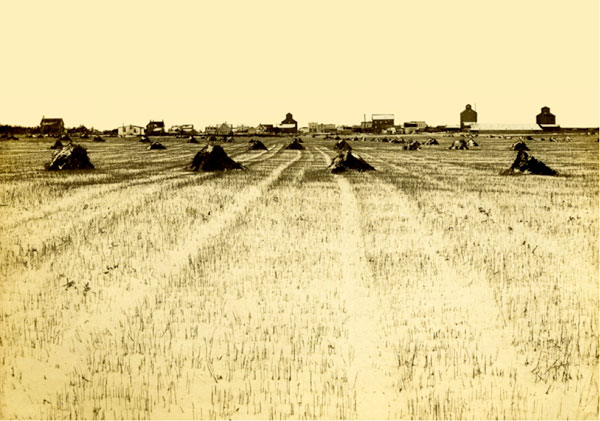
A wide view from the south, dated Sept. 13, 1903. That is snow on the
ground!
From the September 17, Baldur Gazette; “This is one of the worst falls
our farmers have had to contend with. All unstacked grain was saturated
through and through by Saturday’s big rain and snow storm, and it is
feared that a great many of the stacks have let in the wet.”
1906
Discussions and plans for a new church began at Bru in 1906. Three
years later the decision was made to build a new church.
1907
In 1907 the Lutheran Church was built on the corner of Government Road
and Carey Street. It was a white brick edifice. The dedicatory service
took place on Nov. 24th, 1907.
1908
Thor SD. # 1430 established on 28-5-13
Telephone service expands throughout the municipality.
By 1908, an Icelandic suffrage group called “Sigurvon,” or “Hope of
Victory,” (Also called “The White Band”) was functioning in Argyle, and
several other Icelandic communities followed suit.
The Icelandic Women of Argyle form a suffrage society called “The White
Band”. The Icelandic Suffrage Societies were the first groups organized
solely to promote suffrage in Western Canada.

1910 – 1919
International
________________________________________
1911: Iceland gives the vote to all women over 25.
1912: Titanic sinks after hitting an iceberg on its first voyage.
1914: WW 1 – 1914 – 18
1917: Russian Revolution and the beginning of Communist rule.
Canada
________________________________________
Conscription Crisis
Manitoba
________________________________________
1916: Manitoba is the first province to give women the vote.
1919: Widespread drought. Winnipeg General Strike.
The Argyle Icelandic Settlement
________________________________________
Grund like all Manitoba communities was profoundly affected by the
World War, and like all Manitoba communities is proud of its efforts on
behalf of “King & Country”.

The
Icelandic Settlement 1910 – 1919
1910
Bru Church was built on southeast corner of 21-6-13, with Jon
Olafson of Glenboro as head carpenter, and was called Frikirkju
Lutheran Church
1911
A two manual "Doherty" organ was purchased for Frelsis Church.
1912
Economic downturn in Manitoba – affects much local industry in smaller
communities.
Council set and annual license fee of $5 for motor vehicles.
1913
Nov. 10, 1913, the ladies aid decided to form a special fund and call
it "Memorial Flower Fund" and donated $50.00 in her memory. To this day
the fund is being used for many useful projects, such as redecorating
the church, setting up a steel fence around the graveyard and helping
the needy.
1915
Excellent crop and high grain prices.
Reports of War Casualties continue.
Oliver SD #1766, established on 21-6-13
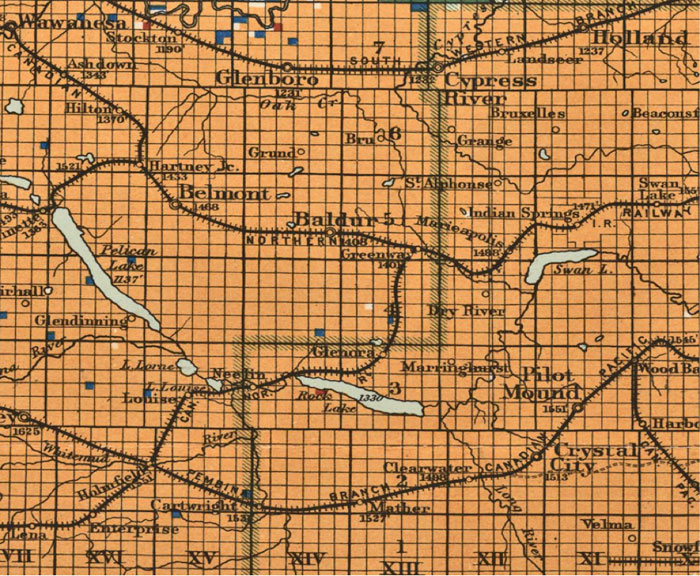
The region in 1915
1916
Recruiting rallies held and local units of the Southern Manitoba
Battalion set up.
On Aug. 19, 1916, a group of young women met at the home of Mrs. B.S.
Johnson with the idea of forming a new society - with the main object
being to work and send parcels to the soldiers - both food and
clothing. A very large number of young men had left the Icelandic
settlement to fight in WW 1. Of course there were other good causes
that they would work for such as helping poor and needy in time of
sickness and also the church community projects as they arose.
After much discussion the society was organized and named "Dorcas
Society". Miss Gudbjorg Goodman was chosen president.
1917
Manitoba Women are given the right to vote.
Drought in Argyle.
1918
The Bru Dorcas Society was formed in early 1918, with Thorbjorg Jonsson
as first treasurer. This society was a group of young women, who
organized for the purpose of making money to do good works. The annual
fee was set at 50¢ per member.
Nov 11 – Armistice ends World War 1
Dry conditions continue.
50 cases of influenza reported in the region.
1919
General depression following the war. Low grain prices.

1920 – 1929
International
________________________________________
The conditions imposed upon Germany after WW1 help trigger an economic
collapse and political turmoil that results leads to the rise of Adolph
Hitler and his Nazi Party.
1927: Charles Lindberg flies solo from New York to Paris.
1929: Stock Market crash signals the beginning of the Great Depression.
Canada
________________________________________
Post-War adjustments are difficult. The “Roaring Twenties” though
fondly remembered, most correctly apply to the latter part of the
decade.
Manitoba
________________________________________
1920: The Manitoba Grain Growers’ Association becomes “The United
Farmers of Manitoba.” It turned its attention to progressive farm
legislation.

The Argyle Icelandic Settlement
________________________________________
Some
General Trends in the 1920’s
Throughout the prairies communities erected various memorials
commemorating the sacrifice and service of those who participated in
the “Great War.”
On farms and in businesses trucks were replacing horses for everyday
tasks.
The adoption of a car-based transportation economy saw the expansion of
car-based service – gas stations, auto repair shops
In recreation, tennis and cricket declined. Hockey continued to grow,
as did curling.
Radio helps connect remote hopuseholds to the rest of the world.

The
Icelandic Settlement 1920 – 1929
1921
Bru School was replaced by a new school on the northwest corner of
11-6-13.
The Sunshine Highway was built through Argyle. It was a network of
roads comprising a designated route from Brandon southeast to link with
highway system in North Dakota (Devil’s Lake). It passes through
Rounthwaite, Wawanesa, Ashdown, Baldur, Glenora, and Crystal
City. Part of that route ran along what was also the most direct route
between Baldur and Glenboro, since replaced by #5 Highway.
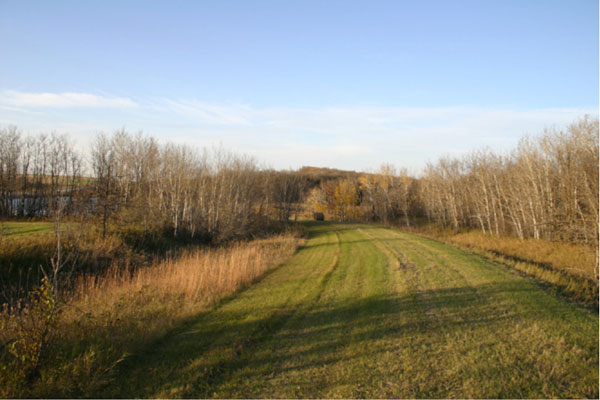
Portions of the Sunshine Highway that were replaced as the road was
straightened have been preserved as a pathway by the owners of the
property.
1922
Argyle Council grants remission on arrear on land settled under the
Soldier Settlement Board.
Wages for skilled workers drops from a dollar and hour to 85 cents.
1925
Rev. Fridrik Hallgrimsson 1903-1925
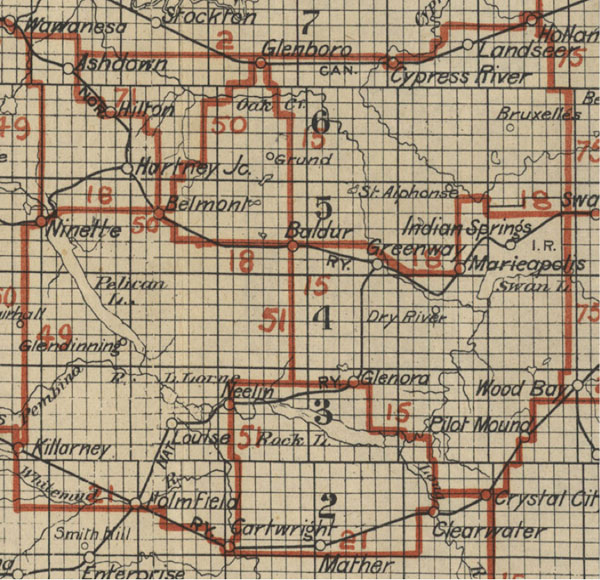
Automobile Road Map of Manitoba (1924)
Emmett, A.C. Automobile Road Map of Manitoba [map]. 1:760,320.
Winnipeg: Stovel Company Ltd., 1924.
Image Courtesy of University of Manitoba Archives & Special
Collections
(Morris Block fonds, MSS 207, A.05-43)
www.umanitoba.ca/libraries/units/archives/collections/com
1927
General upturn in the local economy.
Formation of the Baldur Cooperative Pool Elevator.

1930 – 1939
International
________________________________________
The depression set off by the stock market collapse in late 1929 is
felt across North America and Europe.
Sept.1, 1939: Germany invades Poland, setting off World War 2.
Canada
________________________________________
The effect of the world-wide economic depression is compounded in
Western Canada by an extended drought.
In 1936 the Federal Government cancelled debt for feed and wrote off
many advances to to the drought areas.
Manitoba
________________________________________
The effects of the drought on the prairies are felt most acutely in the
southwest corner of the province.
The Farmer’s Creditors Arrangement Act – aims to reduce farm debt loads.
The Argyle Icelandic Settlement
________________________________________
The depression and the drought affect Argyle much as they affect
other communities.
The expansion of the role and scope of schools, the influence of radio,
and the changing technology in transportation all had an effect on
life.

The Icelandic Settlement 1930 – 1939
1930
Rev. K.K. Olafson (Frelsis) 1925-1930
The Bru Young People's Society was organized by Rev. E. Fafnis in
1930-31.
The Grund Young People's Society was organized in Skjaldbreid Hall on
July 9, 1930.
1931
Milk cows sold for $30. A phone call was 5 cents, but even at
that price many people gave up the telephone.
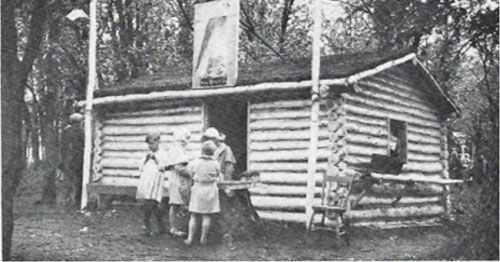
Log cabin built in 1931 to celebrate the 50th anniversary oj Icelandic
settlement.
1935
Good rains early but the wheat crop rusted and rotted.
On July 28, 1935, a celebration was held to mark the 50th anniversary
of Frelsis Congregation. After a short service in the church, lunch was
served to a large crowd in Argyle Hall. Rev. B.B. Jonsson was invited
to be guest speaker.
1936
Hot dry summer.
Federal Drought Relief Program established.
Dr. A. Keenberg was appointed the first Municipal Doctor.
1937
Spring rain leads to an improved harvest.
1938
Abundant crops.
1939
September 1: Hitler invades Poland and World War II begins.

1940 – 1949
International
________________________________________
December, 1941: The United States enters the war after Japanese
attack on Pearl Harbour
1945 – WW2 ends.
Canada
________________________________________
Aug. 19, 1942: Nearly 1000 Canadians die and 2000 are taken prisoner in
the failed raid on Dieppe.
Manitoba
________________________________________
Rationing and consumer goods shortages become a way of life.
Manitoba Power Commission decides to extend service to more rural
areas.
The Argyle Icelandic Settlement
________________________________________
Record harvests in 1940 began a period of relative prosperity to rural
Manitoba. The war effort was foremost in people’s minds throughout the
early 40’s.

The
Icelandic Settlement 1940 – 1949
1945
The return of soldiers, many with war brides, signals the beginning of
the “Baby Boom”.
Rev. Egill Fafnis (Frelsis) 1930 - 1945
1946
Council received a matching grant of $4000 to work on the Baldur-
Glenboro road.

 
|
|